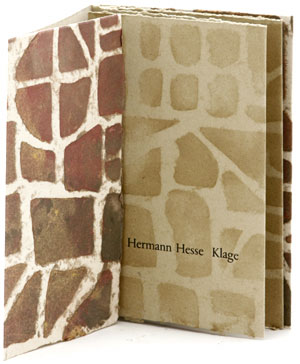 At the Codex Book Fair last week, I stopped by book binder John DeMerritt’s table to say hi and admire his wife Nora’s new book. We started talking about paper, and John said to be sure to look at the pulp painted papers made by John Gerard at the table across from him. I was immediately entranced by the beautiful papers and bought the chapbook on the left. It’s very simply made — an accordion text block with a letterpress printed poem is pamphlet sewn into the covers, but it shows off the paper so well!
At the Codex Book Fair last week, I stopped by book binder John DeMerritt’s table to say hi and admire his wife Nora’s new book. We started talking about paper, and John said to be sure to look at the pulp painted papers made by John Gerard at the table across from him. I was immediately entranced by the beautiful papers and bought the chapbook on the left. It’s very simply made — an accordion text block with a letterpress printed poem is pamphlet sewn into the covers, but it shows off the paper so well!
 To make a pulp painting, specially prepared pulps are applied to a freshly made sheet of handmade paper, sometimes with the aid of stencils, sometimes freehand, so that when it all dries, the finished sheet of paper fully incorporates the image. Several years ago, we had an article in the Ampersand about Claire Van Vliet’s large pulp painted broadsides — you can see two of them online: What evaluation we make of a particular stretch of land… and this glorious one called A Scribe of Kloster Eibingen with pulp painting, letterpress and silkscreen.
To make a pulp painting, specially prepared pulps are applied to a freshly made sheet of handmade paper, sometimes with the aid of stencils, sometimes freehand, so that when it all dries, the finished sheet of paper fully incorporates the image. Several years ago, we had an article in the Ampersand about Claire Van Vliet’s large pulp painted broadsides — you can see two of them online: What evaluation we make of a particular stretch of land… and this glorious one called A Scribe of Kloster Eibingen with pulp painting, letterpress and silkscreen.
 I seem to be in a poetry reading mood recently — the Hesse poem in my new acquisition is in German, but I found a translation online by Joseph Knecht:
I seem to be in a poetry reading mood recently — the Hesse poem in my new acquisition is in German, but I found a translation online by Joseph Knecht:
Lament
by Hermann Hesse
No permanence is ours; we are a wave
That flows to fit whatever form it finds:
Through day or night, cathedral or the cave
We pass forever, craving form that binds.
Mold after mold we fill and never rest,
We find no home where joy or grief runs deep.
We move, we are the everlasting guest.
No field nor plow is ours; we do not reap.
What God would make of us remains unknown:
He plays; we are the clay to his desire.
Plastic and mute, we neither laugh nor groan;
He kneads, but never gives us to the fire.
To stiffen to stone, to persevere!
We long forever for the right to stay.
But all that ever stays with us is fear,
And we shall never rest upon our way.
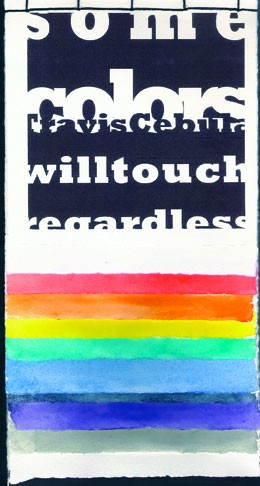 Another book I enjoyed from the Handmade/Homemade exhibit I saw last week was Some Colors Will Touch Regardless, with a poem by Travis Cebula and designed by Fact Simile Press. The press has a yearly chapbook contest, and Cebula was a runner-up. Fact Simile designs and publishes an artist book for the 3 winners.
Another book I enjoyed from the Handmade/Homemade exhibit I saw last week was Some Colors Will Touch Regardless, with a poem by Travis Cebula and designed by Fact Simile Press. The press has a yearly chapbook contest, and Cebula was a runner-up. Fact Simile designs and publishes an artist book for the 3 winners.![]() The book is a simple Japanese-bound set of cascading pages, each colored at the bottom and hand torn. The color strips echo the title, and in addition, the poem on each page mentions the color on its edge. The presentation is a simple structure but elegantly dovetails the poetry inside.
The book is a simple Japanese-bound set of cascading pages, each colored at the bottom and hand torn. The color strips echo the title, and in addition, the poem on each page mentions the color on its edge. The presentation is a simple structure but elegantly dovetails the poetry inside.![]() Unfortunately the edition is sold out, but look here to see more books published by Fact Simile.
Unfortunately the edition is sold out, but look here to see more books published by Fact Simile.
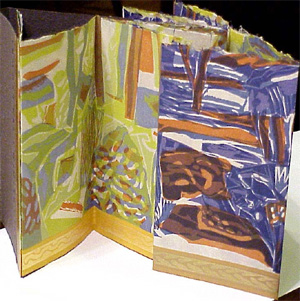 I haven’t written recently about my fledgling
I haven’t written recently about my fledgling 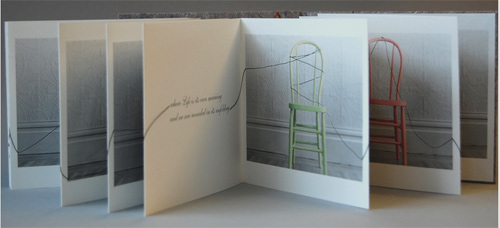
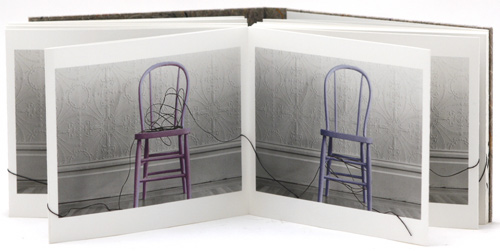
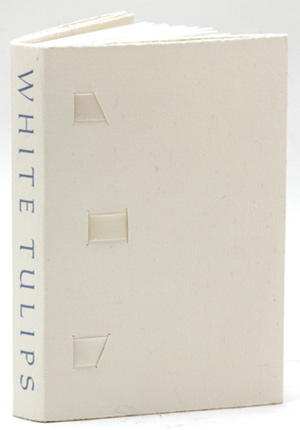 A favorite in my collection is White Tulips, ninety-nine haiku by Ronald Baatz. Leonard Seastone of Tideline Press in upstate-New York designed the book, which he handset in Elizabeth and Carolus type and then letterpress printed on dampened, vintage Barcham Green Hayle paper. Single and fold-out pages alternate throughout the book, with the fold-out ones hiding more haiku for the reader to discover. There are 3 cream-colored strips of ribbon in the binding that make the cover even more beautiful.
A favorite in my collection is White Tulips, ninety-nine haiku by Ronald Baatz. Leonard Seastone of Tideline Press in upstate-New York designed the book, which he handset in Elizabeth and Carolus type and then letterpress printed on dampened, vintage Barcham Green Hayle paper. Single and fold-out pages alternate throughout the book, with the fold-out ones hiding more haiku for the reader to discover. There are 3 cream-colored strips of ribbon in the binding that make the cover even more beautiful.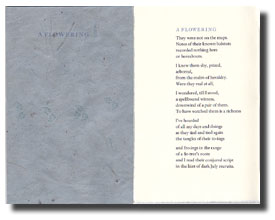
 At the
At the